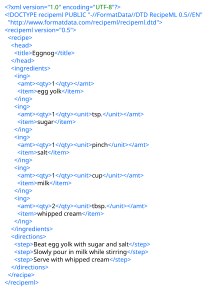
Back لغة توصيف Arabic Nişanlama dili Azerbaijani Маркиращ език Bulgarian মার্কআপ ভাষা Bengali/Bangla Lavar merkañ Breton Llenguatge de marques Catalan Značkovací jazyk Czech Iaith tagio Welsh Markup language Danish Auszeichnungssprache German

A markup language is a text-encoding system which specifies the structure and formatting of a document and potentially the relationships among its parts.[1] Markup can control the display of a document or enrich its content to facilitate automated processing.
A markup language is a set of rules governing what markup information may be included in a document and how it is combined with the content of the document in a way to facilitate use by humans and computer programs. The idea and terminology evolved from the "marking up" of paper manuscripts (e.g., with revision instructions by editors), traditionally written with a red pen or blue pencil on authors' manuscripts.[2]
Older markup languages, which typically focus on typography and presentation, include Troff, TeX, and LaTeX. Scribe and most modern markup languages, such as XML, identify document components (for example headings, paragraphs, and tables), with the expectation that technology, such as stylesheets, will be used to apply formatting or other processing.[citation needed]
Some markup languages, such as the widely used HTML, have pre-defined presentation semantics, meaning that their specifications prescribe some aspects of how to present the structured data on particular media. HTML, like DocBook, Open eBook, JATS, and many others, is based on the markup meta-languages SGML and XML. That is, SGML and XML allow designers to specify particular schemas, which determine which elements, attributes, and other features are permitted, and where.[3]
A key characteristic of most markup languages is that they allow intermingling markup with document content such as text and pictures. For example, if a few words in a sentence need to be emphasized, or identified as a proper name, defined term, or another special item, the markup may be inserted between the characters of the sentence.
- ^ "markup language | Definition, Examples, & Facts". Encyclopedia Britannica. Archived from the original on 2020-10-26. Retrieved 2022-08-17.
- ^ Siechert, Carl; Bott, Ed (2013). Microsoft Office Inside Out: 2013 Edition. Pearson Education. p. 305. ISBN 978-0735669062.
Some reviewers prefer going old school by using a red pen on printed output
- ^ "SGML Markdown Typography Documentation". smljs.net. Retrieved 2025-01-02.